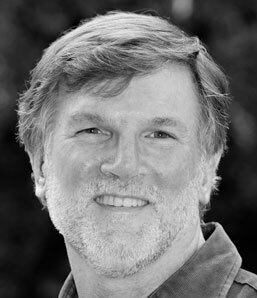Building Capacity in Collecting and Conserving Crop Wild Relatives
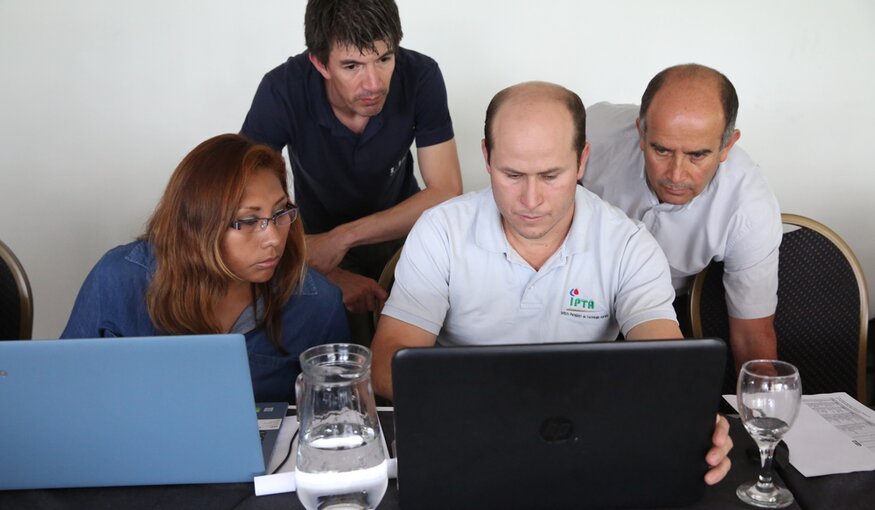 “Genetic resources safeguarded in a genebank are useful only if they are accompanied by data that is easy to access and can be trusted,” says Juan Carlos Alarcón, the GRIN-Global Frontrunner, who is pictured here far right with representatives from (L to R) Bolivia, Uruguay and Paraguay. “The management of information is indispensable to safeguard the diversity of our crops. And, more importantly, to make it available to potential users.” Photo: Genebank Platform
“Genetic resources safeguarded in a genebank are useful only if they are accompanied by data that is easy to access and can be trusted,” says Juan Carlos Alarcón, the GRIN-Global Frontrunner, who is pictured here far right with representatives from (L to R) Bolivia, Uruguay and Paraguay. “The management of information is indispensable to safeguard the diversity of our crops. And, more importantly, to make it available to potential users.” Photo: Genebank Platform27 July 2020
How do you go about finding and collecting seeds from a scraggly looking crop wild relative in a prairie or a tropical forest, when you’ve never done it before? Once you’ve collected them, how do you keep track of the seeds conserved in your genebank? These are but two of the key questions that have been addressed in numerous workshops that have been carried out worldwide as part of the Crop Wild Relatives (CWR) Project.
Since the project began, training has been offered in collecting and conserving seeds, pre-breeding methods, developing quality management systems for genebanks and comprehensively managing the data that accompanies this diversity.
“As our partners gain or expand their technical abilities, skills and know-how they become stronger professionals,” said Benjamin Kilian, CWR Project coordinator. “Beyond the seeds collected or the countless crosses made to climate-proof our crops, this is the unseen, added value that the CWR Project brings.”
The CWR Project connects and supports national and international actors who collect, conserve and use crop diversity. “Our partners are at the front lines of climate change adaptation and mitigation; they see how fast natural environments are disappearing, they’ve documented how sturdy and valuable the wild cousins of our crops are, and they know what needs to be done to confront this climate emergency,” said Benjamin. “It is important that we support them by helping them to extend their skills through capacity building.”
The GOAL of training
To provide the highest standards of capacity building, the Crop Trust has forged alliances around the world. One longstanding partner has been the Crawford Fund, an Australian non-profit organization which supports international agricultural collaboration and capacity building in the Asia-Pacific region.
The Crawford Fund has engaged Michael Mackay, an associate professor at the Queensland Alliance for Agriculture and Food Innovation at the University of Queensland, to develop a curriculum for genebank staff. The Crop Trust and Crawford Fund are now working together to support the implementation of so-called Master Classes in Genebank Operations and Advanced Learning (GOAL) in Asia and the Pacific.
The first joint activity was in November 2015, in India. The Master Class helped 21 participants from national genebanks in the region improve their knowledge and skills in information management, quality control and standard genebank operating procedures.
Michael was surprised to learn how similar the needs were in genebanks in different countries. “Learning how to accurately document agreed operating procedures for all genebank activities, and applying them faithfully, was the most impactful way for participants to improve their genebank operations,” he reported.
The Crawford Fund has helped support a number of other GOAL workshops since then. “To date, we have conducted five annual GOAL Master Classes,” said Michael. Last year, a workshop was held in Vietnam, hosted by the Plant Resources Center (PRC) of the Vietnam Academy of Agricultural Sciences (VAAS). It brought together data managers from 12 national and regional genebanks in Asia-Pacific and focused on learning best practices in genebank documentation management. It provided an introduction to Genesys and updated participants on new developments in GRIN-Global.
“A lot of the genebanks had people who were appointed from other roles to run the place,” said Michael. “This meant they were often working in a kind of information vacuum. So during the GOALs they raised numerous issues they were facing and the group of trainers we had there were able to provide options for achieving constructive and sustainable outcomes.”
“Our goal as custodians of these invaluable genetic resources is to conserve them at the highest standard possible,” said Janny van Beem, Genebank Quality Management Specialist at the Crop Trust, who has involved in developing and teaching the GOAL workshops. “These workshops provide genebank staff with the tools and skills they need to adopt best practices, and achieve excellence in genebank management, and that means both the seeds and the associated data.”
Beyond providing capacity building in technical and scientific issues, the workshops also provide an opportunity to tackle other aspects of the work of genebanks which are equally important in safeguarding and sharing germplasm. International policies such as those put in place by the International Plant Protection Convention and the International Treaty on Plant Genetic Resources for Food and Agriculture (ITPGRFA) are also discussed and agreement reached on how to best implement and adhere to them.
One of the lasting contributions of GOAL is the creation of communities of practice in different regions. “National genebanks can be relatively isolated,” said Janny. “Once the CWR Project created the space for them to meet regularly, genebank staff had the opportunity to get to know each other and discuss the challenges that they all face. This has led to an increase in communication, including sharing of documentation and site visits; an improvement of operations is inevitable when information and experiences are pooled in this way.”

Participants of 2019 GOAL workshop in Vietnam, hosted by the Plant Resources Center (PRC) of the Vietnam Academy of Agricultural Sciences (VAAS).

Michael Mackay addresses participants during GOAL workshop in Vietnam in 2019
The language of training
The CWR Project has also teamed up with national partners to organize GOAL workshops. Together, Crop Trust and Uruguay’s National Agricultural Research Institute (INIA) supported a GOAL workshop in Montevideo in December 2019. Genebank staff from nine South American countries attended this fourth capacity building workshop in Latin America since 2015. Instruction was in Spanish, and Genesys, data validation tools and GRIN-Global were on the curriculum.
“These capacity building activities offer us opportunities to meet with our colleagues, to share our experience, and to know we’re not alone,” said workshop host Federico Condon, Genebank Manager at INIA. “It allows us to network and build professional relationships with other women and men who are also searching for the best way to use their limited resources, both human and financial, to conserve our priceless genetic diversity.”
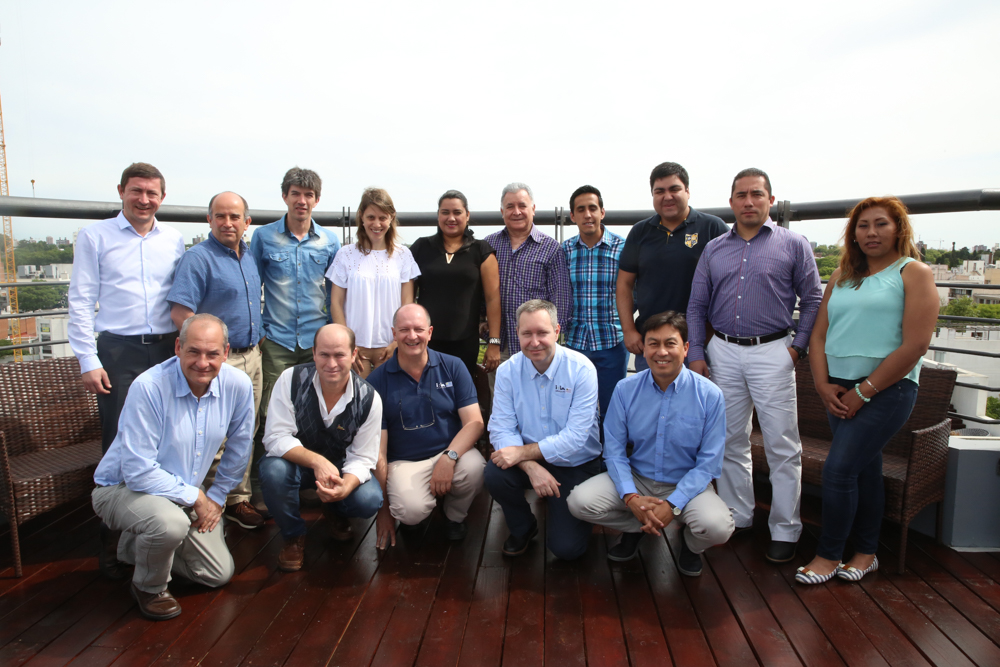
The 2019 GOAL-Data Workshop in South America was hosted by the National Agricultural Research Institute (INIA) Uruguay, where representatives from nine national genebanks came together in a lively, week-long workshop that strengthened their data management practices. Inventories, policies, automation, data cleaning – all these and more are important to ensure crop diversity collections are safe and readily available in a genebank.
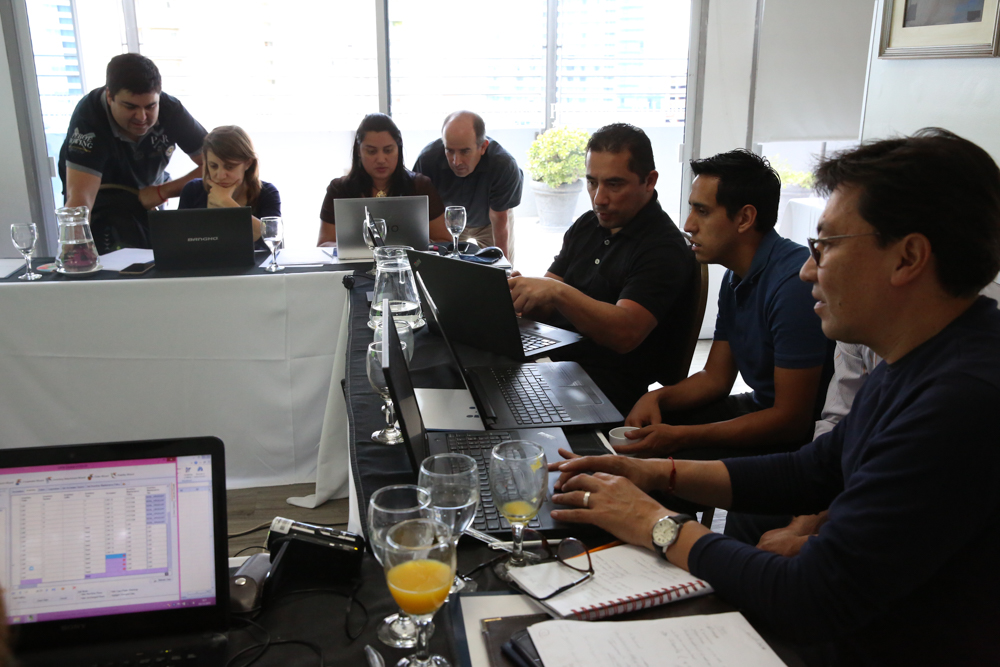
During the 2019 GOAL-Data Workshop, participants explored the many uses of Genesys-PGR, a database which allows users to explore the world’s crop diversity conserved in genebanks, and GRIN-Global, an information system designed to help genebanks manage data on their germplasm collections.
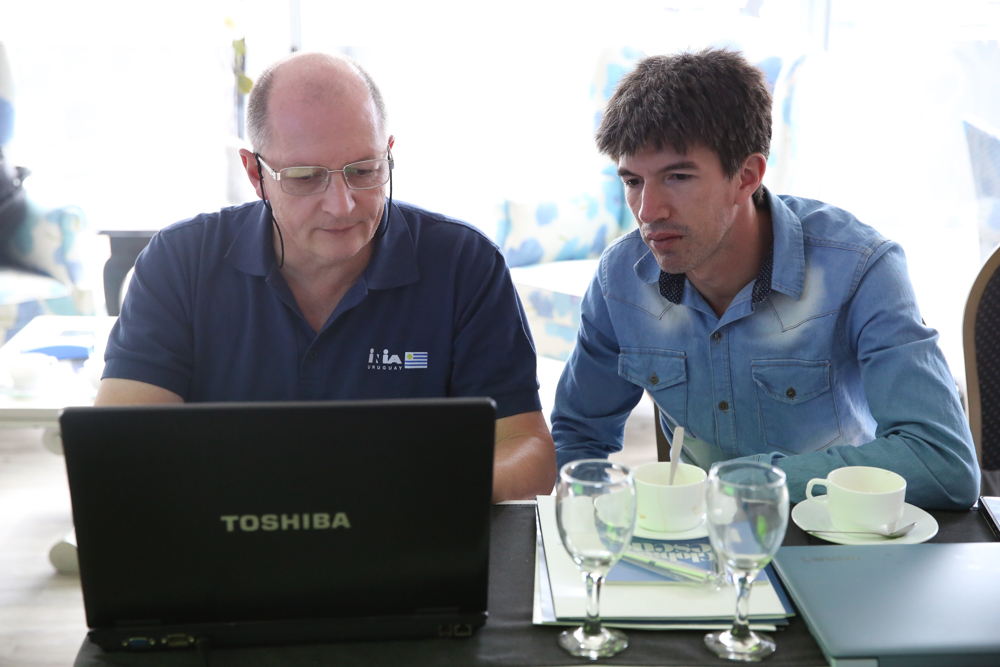
Pictured here, Federico Condón (L) and Sebastían Ríos (R), from INIA Uruguay, work through a Genesys-PGR data validation exercise. According to Federico, among the many benefits that Genesys-PGR offers genebanks is the site’s capability to display maps. “Visualizing where our crop collections have been collected has great potential for us and genebank users everywhere. For example, this can inform how we fill gaps in a collection. And researchers can explore specific ecological zones for adapted germplasm.”
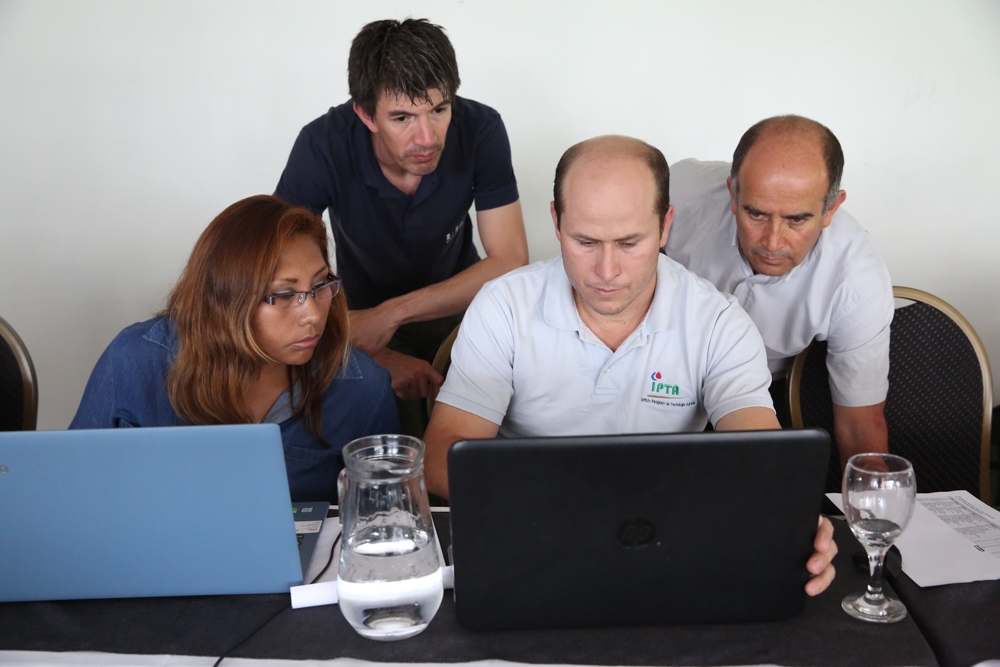
“Genetic resources safeguarded in a genebank are useful only if they are accompanied by data that is easy to access and can be trusted,” says Juan Carlos Alarcón, the GRIN-Global Frontrunner, who is pictured here far right with representatives from (L to R) Bolivia, Uruguay and Paraguay. “The management of information is indispensable to safeguard the diversity of our crops. And, more importantly, to make it available to potential users.” Photo: Genebank Platform
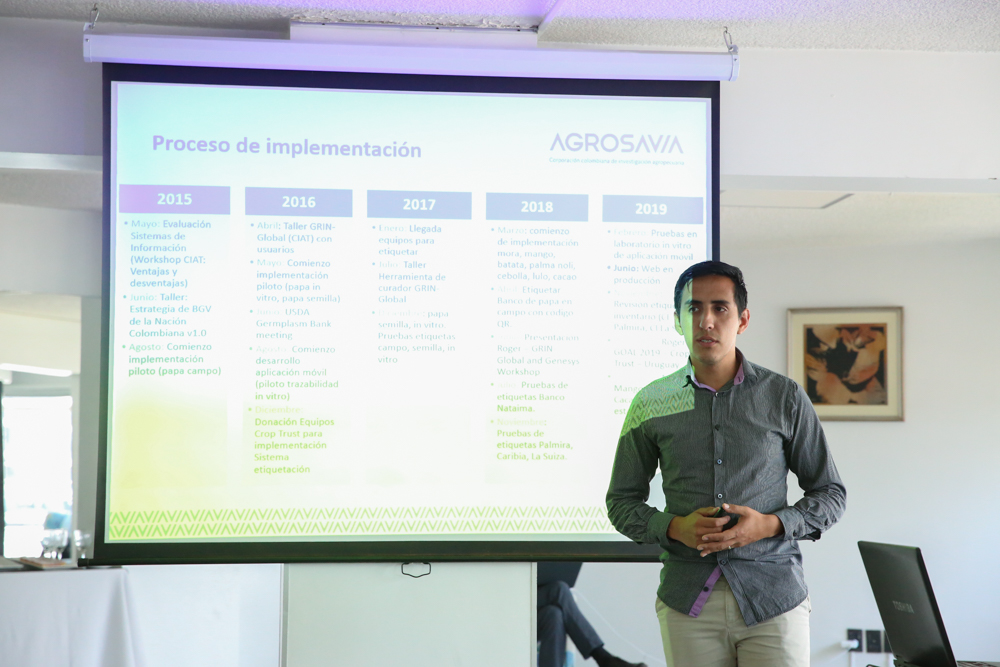
During the 2019 GOAL-Data Workshop, representatives from Uruguay, Colombia and Chile explained how GRIN-Global was adopted and implemented in their institutes. “This information system has really helped with the operational management of the collections held by AGROSAVIA,” said Roger Garzón, from AGROSAVIA, Colombia (pictured here). “It is important to contribute to the GRIN-Global community, to share experiences and find solutions to make the most of the software’s potential.”
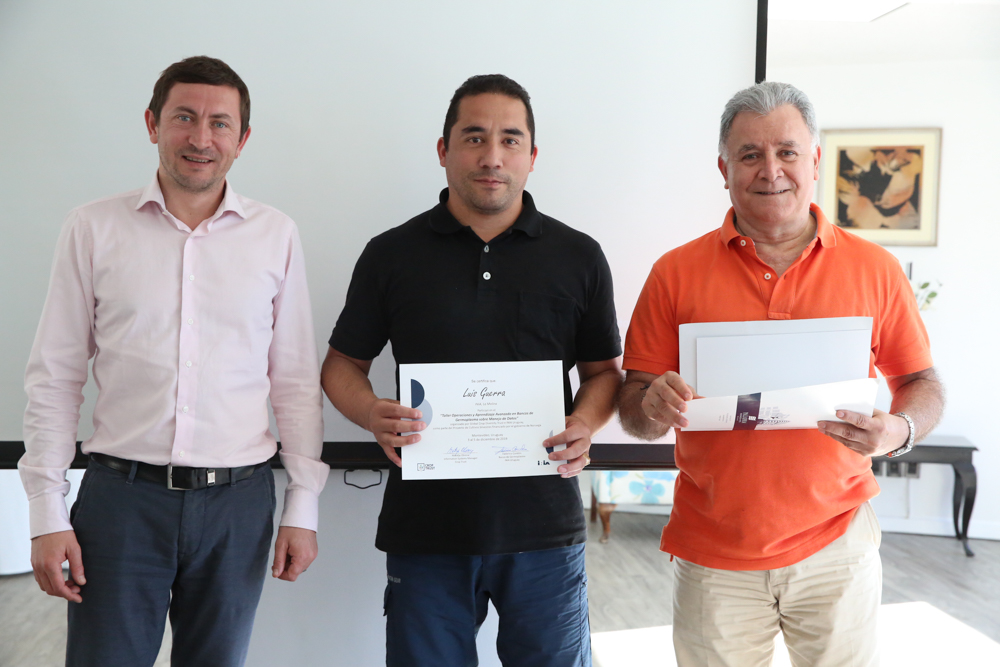
Flanked by Crop Trust representatives Matija Obreza (L) and Tito Franco (R), Luis Enrique Arevalo, from INIA, Peru, poses for the camera. Luis Enrique was impressed how Genesys-PGR can assist genebanks in sharing information globally. “The international plant genetic resources community must work together and learn from each other,” he said. “Workshops like this are needed to maximize the use and impact of our limited resources.”
A horizontal approach
The objective of these capacity building workshops, whether they in Asia, Africa or Latin America, is more effective management of genetic resources. Tools and strategies that can help with that are presented and discussed, but it’s never a top-down approach. Rather, partners come together to share their experiences and their challenges, and to learn from each other.
“For example, in Uruguay, our colleagues from Chile, Colombia and Uruguay presented their experience using GRIN-Global to the group,” said Matija Obreza, the Crop Trust’s Information Systems Program manager. “They had different challenges and found different solutions. Now the other genebanks have a range of options, and some people to turn to if they get stuck. At the end of the day, that’s the goal: to help genebanks help each other to do their job as well as they possibly can.”
Read more
- GOAL — Raising Genebank Standards
- Collecting and Long-Term Conservation of Crop Wild Relative Seeds: The Uganda Training Course 2014
- Collecting Seeds Is Not Easy: A Crop Wild Relatives Video-interview
- Mastering the Genebank Social Network
- Training in Malaysia
- Training in Chile, in Spanish
- GOAL in Costa Rica, in Spanish and in English
Categories: Genebank Platform, Genebanks

